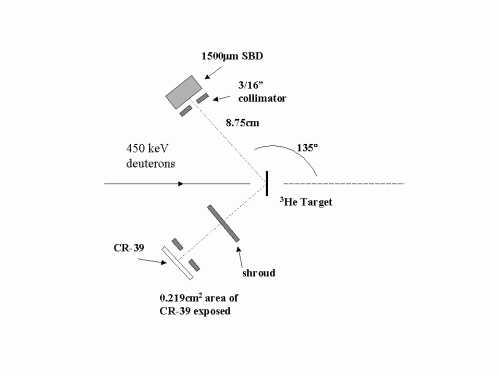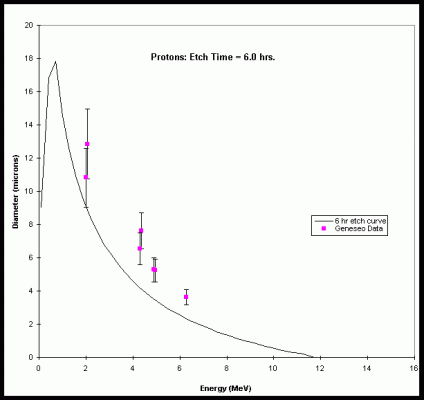CR-39 Hole Size
A Comparison of Particle Energy Distributions and CR-39 Track Diameter Distributions for 13.8-MeV Protons Through Aluminum Degrading Foils
-K. Fletcher, M. Olsen, B. Schwartz
In the Charged Particle Spectrometers, aluminum degrading foils are used to range high energy charged particles to lower energies – energies for which CR-39 detection is most sensitive. In addition to lowering the average energy of the initially monoenergetic protons, energy straggling through the aluminum results in a broadening of the energy distribution. This, in turn, contributes to a broadening of the distribution of track diameters in the CR-39.
We investigated this experimentally using the 2-MeV Van de Graaff accelerator at the SUNY Geneseo Nuclear Structure Laboratory. The high energy protons were produced via the 3He(d,p)4He reaction, initiated with 450-keV deuterons on a 3He target. The target was produced by implanting 3He ions into a tantalum foil at an energy of 17 keV, so that the 3He is located within 0.2 µm of the surface of the target. The reaction kinematics requires that protons emitted at an angle of 135° have an energy of 13.817 MeV. As indicated in the figure, 3/16″-diameter collimators were placed on either side of the reaction at 135°, 8.75 cm from the target. A 1500-µm surface barrier detector was mounted behind one of the collimators and CR-39 was mounted behind the other, so that the solid angles were matched. A “shroud” thick enough to stop the high energy protons was mounted on a movable arm in from of the CR-39. To expose the CR-39, this shroud was rotated out of the way.

The energy calibration of the surface barrier detector was determined using the 13.817 MeV d-3He protons and the 2.593 MeV protons produced via D(d,p)3H, using a thin, deuterated polyethylene target. For the calibration measurements two layers of mylar, 3-µm thick, were mounted in front of the detector to absorb elastically scattered deuterons, and TRIM was used to determine that the protons would have 13.788 and 2.483 MeV, respectively. We checked the calibration using two other peaks. The 12C(d,p) proton, an artifact of the polymer target, appeared in the calibrated spectrum at 2.606 MeV. Kinematics and energy loss through the 6 µm of mylar predicts an energy of 2.616 MeV. Similarly, alpha particles are produced via 3He(d,a)p. The alphas emitted at 135° should have an energy of 2.738 MeV, which is reduced to 1.537 MeV after the mylar filter. The energy centroid for these alphas on the calibrated spectrum was 1.543 MeV.
Measurements were taken using different aluminum absorbers, as characterized in Table 1. The CR-39 samples were transported to LLE where Sam Roberts and Chuck Sorce analyzed them, using the standard, 6-hour etch protocol. Graph CR1 shows a comparison between the predicted track diameter vs. proton energy and the experimental results. The predictions underestimate the track diameter over this energy range. The remaining CR graphs show comparisons of energy and diameter distributions. These graphs are plotted so that the centroids of each are aligned and the range of the track diameter graph covers three standard deviations on each side. The limits of the energy graphs were chosen to correspond to the limits of the track diameters.
SBD
Calibrated E |
TRIM E |
CR-39 |
Density |
||||||
| Al (um)> | (MeV) |
+ | S.D. | (MeV) |
+ | S.D. | protons/mSr/BCI | Tracks/mSr/BCI | Ratio |
814 |
6.27 |
+ | 0.19 |
6.47 |
+ | 0.20 |
0.47 |
0.56 |
0.84 |
924 |
4.95 |
+ | 0.24 |
5.05 |
+ | 0.28 |
0.45 |
0.53 |
0.84 |
924 |
4.90 |
+ | 0.26 |
5.05 |
+ | 0.28 |
0.42 |
0.47 |
0.89 |
960 |
4.30 |
+ | 0.28 |
4.22 |
+ | 0.29 |
0.44 |
0.46 |
0.96 |
960 |
4.37 |
+ | 0.25 |
4.22 |
+ | 0.29 |
0.54 |
0.39 |
1.40 |
1054 |
2.01 |
+ | 0.51 |
1.99 |
+ | 0.49 |
0.43 |
0.42 |
1.03 |
1054 |
2.06 |
+ | 0.64 |
1.99 |
+ | 0.49 |
0.42 |
0.30 |
1.38 |
The number of protons detected per unit solid angle per unit incident deuteron charge (BCI) was determined for the surface barrier detectors and CR-39. It is interesting to note that the values do not agree. This may be an indication of the sensitivity or efficiency of the track detection procedure, although more study should be done on this before any conclusions can be reached.

